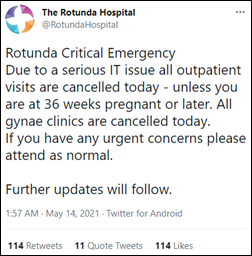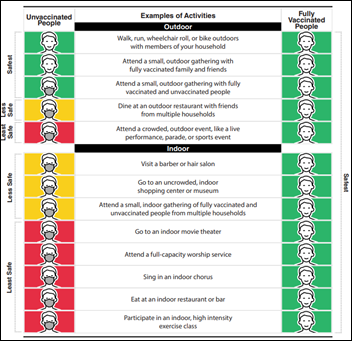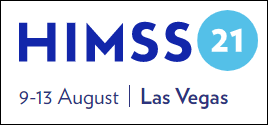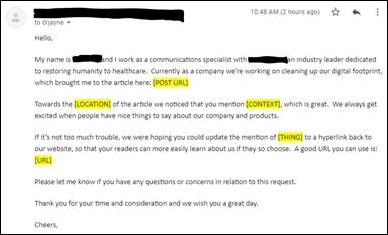Top News

Aetion, which offers a real-world evidence platform for drug companies and payers, raises $110 million in a Series C funding round, increasing its total to $212 million.
Former FDA Commissioner Scott Gottlieb, MD serves on the company’s board.
Reader Comments
From Mr. F: “Re: HIMSS. I am a long-time member, speaker, and volunteer for HIMSS, but for the first time ever I find myself on the vendor side. We are about to pull the trigger on investing in exhibiting so I asked HIMSS to share as of today (91 days prior to the conference) how is registration looking compared to 91 days prior to the start of the 2019 conference. I was provided the following from HIMSS — approximately 2,800 registered in-person attendees for HIMSS21 (made sure they removed the digital-only participants) compared to 2,000 registered attendees this time in advance of the 2019 conference. The HIMSS employee also commented that it is a significantly larger proportion of C-Suite attendees and extremely high engagement on the conference website.” It seems odd that a conference with 42,000 attendees in 2019 had less than 5% of them registered 90 days out since it’s hardly an impulse item and you lose out on early bird pricing. That makes me wonder how many of the total headcount were full-paying registrants versus exhibitors, students, etc. I suppose those exhibitors who rent the HIMSS21 attendee list will get an early idea of attendance and job breakout. There’s also the question whether the many folks who rolled over their HIMSS20 registrations for free will actually show up to HIMSS21 given their unprecedented lack of skin in the game. Exhibitor count is at 462. I assume Mr. F’s pseudonym identifies them as a fellow fan of “Arrested Development,” to which I extend them a belated Happy Cinco de Cuatro.
From Job Hopper: “Re: employment. The near end of the pandemic seems like a good time to start job-hunting, so I am.” I expect a heightened level of employee churn over the next several months as folks start to feel free to move around after a long hibernation, companies are likely to be hiring, and remote work policies become a bargaining chip. That will be magnified by the recruiting efforts of new companies that are flush with investor cash and need more bodies to chase the pitch deck promises of hockey stick growth.
From Bama Jelly: “Re: Ro and other telehealth prescription companies. What standards do you suppose they use in evaluating a ‘patient’ who will become a ‘customer’ only if the doctor clears them?” Probably the same as my thankfully short-term vendor days in which I was tasked with filling out zillion-page RFPs — the answer is always “yes” unless (a) all possibilities have been exhausted, including custom programming and manual intervention; and (b) even then, someone in sales will probably twist your arm into semi-agreeing so that they can override your “no” to “yes” given the lack of a “sort of” as an option. I would be shocked if the hired gun doctors aren’t retained based on their percentage of evaluations that result in prescriptions, which they can probably justify by the minimal vetting that happens in the office anyway and that they can save time and thus make more money by going straight to yes. I would also wager that the forms that patients fill out nudge them into saying whatever it takes to get what they’ve already decided they want. Billions of dollars of investment has been poured into companies whose business model is based on hiring rubber-stamp doctors to bypass the good-intentioned by often bureaucratic prescribing process. I’ve known doctors over the years who just did this on their own and kept the proceeds for themselves, so mass corporatization is the only new feature.
HIStalk Announcements and Requests

Welcome to new HIStalk Platinum Sponsor Twistle. The Albuquerque, NM-based company uses secure, patient-centric communication to drive care plan and protocol adherence, improve outcomes, lower costs, and build brand loyalty. A library of multi-disciplinary clinical communication pathways and best practices, combined with remote physiologic monitoring capabilities, generates clinical, financial, and operational ROI, such as 90% patient engagement rates, 20% improvement in medication / device adherence, 32% fewer readmissions, and more. Care teams realize productivity gains through the automatic initiation of personalized, HIPAA-compliant message pathways, and alerts and dashboards that focus attention on patients that require early intervention. Twistle enhances virtual healthcare initiatives by keeping patients on track as they navigate care journeys. The company offers case studies from Virginia Mason, Providence, AdventHealth, ChristianaCare, Swedish, and others. Check out the video, “The Narrated Patient Experience with Twistle.” Thanks to Twistle for supporting HIStalk.
Today I learned a fun saying from the Internet: “the plural of anecdote is not data.” I will pair that with the Twitter bio of my favorite COVID-19 information source Ashish Jha, MD, MPH, which says “an ounce of data is worth a thousand pounds of opinion.”
Dear companies and PR firms, I genuinely appreciate that you are often now including a LinkedIn bio link to your company new executive hire announcements since that’s where I look for what I need for my “People” section (advanced degrees, previous job, and headshot).
Webinars
June 3 (Thursday) 2 ET: “Diagnosing the Cures Act – Practical Prescriptions for Your Success.” Sponsor: Secure Exchange Solutions. Presenters: William E. Golden, MD, MACP, medical director, Arkansas Medicaid; Anne Santifer, executive director, Arkansas Department of Health – Office of Health Information Technology; Kyle Meadors, principal, Chart Lux Consulting. A panel of leading experts will provide practical guidance on how to prepare for the Cures Act. Will it upend your business model? What is information blocking? How can standardized technologies be applied to meet Cures Act requirements? What must I do now as well as in the next five years?
Previous webinars are on our YouTube channel. Contact Lorre to present your own.
Acquisitions, Funding, Business, and Stock
CPSI reports Q1 results: revenue down 3%, EPS $0.28 versus $0.28, beating estimates for both. CPSI shares are up 33% in the past 12 months versus the Nasdaq’s 47% gain, valuing the company at $444 million.
Nuance announces Q2 results: revenue up 10%, adjusted EPS $0.20 versus $0.16. The company’s acquisition by Microsoft remains on track, to be closed by the end of the year.

Heartbeat Health raises $20 million in a Series B funding round. The New York City-based company offers a cardiovascular care management platform that includes telemedicine, remote diagnostics, and digital health programs. I interviewed CEO Jeffrey Wessler, MD last year.

Automated care workflow company Memora Health raises $10.5 million. The company, which launched out of Y Combinator in 2018 with its proprietary “Felix” software and six employees, now serves patients at 55 healthcare facilities with a staff of 22.
Sales
- The Oklahoma Health Care Authority selects Orion Health’s Amadeus data-sharing software to power its statewide HIE, set to go live this fall. Consulting firms HealthTech Solutions and Cureous Innovations will also assist with HIE development.
- Jackson Hospital (FL) will implement Emerge’s ChartScout and ChartPop medical record data search, visualization, and reporting software.
- Tandigm Health (PA) selects NextGate’s Enterprise Master Patient Index and Provider Registry.
- Temple University Health System chooses ElectrifAi’s machine learning models for contracting and financial accounting.
People

Vish Anantraman, MD, MS (Northwell Health) joins Mayo Clinic as CTO.

Digital voice assistant company Suki promotes Erin Palm, MD to VP of clinical.

Wes Cronkite (Bright Spring Health Services) joins CPSI in the new role of chief innovation officer.


Edifecs names Sundar Shenbagam (Oracle) SVP of engineering and Scott Davis (MedeAnalytics) associate VP of product marketing and demand generation.

AMIA hires Tanya Tolpegin, MBA (American Academy of Audiology) as CEO, returning to pre-Don Detmer separation of the CEO (hired) and president (elected) jobs in which the former manages the organization and the latter handles the science and policy.

Loyal hires Tyler Bennett, MS (Icebreaker) as VP of operations and analytics.

GetWellNetwork hires Todd Strickler, MBA (Marriott International) as SVP of product.
Announcements and Implementations

Olive establishes an AI command center at TriHealth’s offices in Cincinnati to help the six-hospital system automate tasks, initially starting with its revenue cycle. Olive, which has raised nearly $500 million since launching in 2013, has established 22 such sites across the country and plans to develop over 40 more by year’s end.

In an effort to help hospitals reduce call wait times, Well Health’s communication software now gives patients the option to switch their calls to text messaging and automatically receive texts when their calls are dropped or abandoned.
Surescripts will sunset v10.6 of its E-Prescribing and Medication History services in accordance with the CMS-mandated shift to the National Council of Prescription Drug Programs SCRIPT Standard v2017071 on September 1.
COVID-19
FDA extends its emergency use authorization to Pfizer’s COVID-19 vaccine to those aged 12-15.
California will allow pediatricians to administer COVID-19 vaccine to children without using its cumbersome, Accenture-developed MyTurn vaccine management system that cost $50 million.
Other

A ransomware attack on pharmacy administrative services business CaptureRx has exposed the PHI of patients at health systems in Pennsylvania, New York, and Vermont; plus the customers of Thrifty Drug Stores.
Australia’s SA Health determines that Microsoft’s RemoteApp feature caused the glitch in its Allscripts Sunrise system that duplicated the last digit of medication doses, mistakenly displaying a 10 mg dose as 100 mg.
A survey of mental health professionals finds that while 50% of them would rather conduct virtual sessions instead of in-person ones, 39% admit that they are distracted by social media and email during those virtual sessions. A similar percentage say their attention wanders because of other people around them, Internet browsing, and noise from outside their home. One-third of those responding say they deliver a lower level of care in virtual sessions, with the #1 problem being distracted clients and the challenge of assessing and engaging them online. Half of the therapists say they were dealing with their own symptoms of anxiety and depression in the past year and 38% were already in therapy themselves before the pandemic.

Reflect on your larger-than-life legacy with this humorous obituary of 48-year-old plastic and reconstructive surgeon Thomas Flanigan, MD, which sounds jarringly self-written but as actually cobbled together by friends after his death from unstated causes using snippets of his annual New Year’s Eve letters. The “Ginger God of Surgery and Shenanigans” expresses pride in his role as “a beacon of light shining upon those who couldn’t scan the internet for their own hilarious and entertaining comic relief.”
Sponsor Updates
- Dutch hospital Alriine Zorggroep expands its enterprise imaging contract with Sectra to include cardiology.
- SOC Telemed names Gyasi Chisley (Cancer Treatment Centers of America Global) and Chris Gallagher, MD (Access Physicians) to its board.
- Agfa HealthCare announces its first enterprise imaging installation in Colombia, at the Fundación Valle del Lili.
- Cerner publishes a new customer story, “Truman Medical Centers/University Health offers community-based vaccine clinics to vaccinate underserved community.”
- The local business paper profiles ChartSpan’s journey to a hybrid work-from-home model.
- CHIME releases a new edition of its Leader to Leader Podcast featuring GAVS Technologies CEO Sumit Ganguli.
- Ellkay features Tivity Health SVP and CIO Sarah Richardson in its Women in Health IT series.
- Ohio’s Hospice expands its relationship with Netsmart to include a 10-year innovation partnership that will focus on enhancing value-based care leveraging the CareFabric platform.
Blog Posts
Contacts
Mr. H, Lorre, Jenn, Dr. Jayne.
Get HIStalk updates.
Send news or rumors.
Contact us.

Comments Off on News 5/12/21





















































Epic's EDI (interoperability) R&D spend is probably more than the total R&D spend of any other competitor. Epic invests millions…